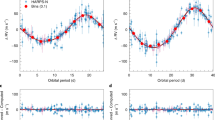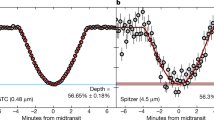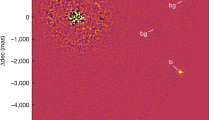Abstract
More than 200 extrasolar planets have been discovered around relatively nearby stars, primarily through the Doppler line shifts owing to reflex motions of their host stars, and more recently through transits of some planets across the faces of the host stars. The detection of planets with the shortest known periods, 1.2–2.5 days, has mainly resulted from transit surveys which have generally targeted stars more massive than 0.75 M⊙, where M⊙ is the mass of the Sun. Here we report the results from a planetary transit search performed in a rich stellar field towards the Galactic bulge. We discovered 16 candidates with orbital periods between 0.4 and 4.2 days, five of which orbit stars of masses in the range 0.44–0.75 M⊙. In two cases, radial-velocity measurements support the planetary nature of the companions. Five candidates have orbital periods below 1.0 day, constituting a new class of ultra-short-period planets, which occur only around stars of less than 0.88 M⊙. This indicates that those orbiting very close to more-luminous stars might be evaporatively destroyed or that jovian planets around stars of lower mass might migrate to smaller radii.
This is a preview of subscription content, access via your institution
Access options
Subscribe to this journal
Receive 51 print issues and online access
$199.00 per year
only $3.90 per issue
Buy this article
- Purchase on Springer Link
- Instant access to full article PDF
Prices may be subject to local taxes which are calculated during checkout




Similar content being viewed by others
References
Mayor, M. & Queloz, D. A. Jupiter-mass companion to a solar-type star. Nature 378, 355–359 (1995)
Marcy, G. W. & Butler, R. P. A planetary companion to 70 Virginis. Astrophys. J. 464, L147–L151 (1996)
Schneider, J. The Extrasolar Planets Encyclopaedia http://www.obspm.fr/encycl/encycl.html.
Butler, R. P. et al. A Neptune-mass planet orbiting the nearby M dwarf GJ 4361. Astrophys. J. 617, 580–588 (2004)
Bonfils, X. et al. The HARPS search for southern extra-solar planets VI. A Neptune-mass planet around the nearby M dwarf Gl 581. Astron. Astrophys. 443, L15–L18 (2005)
Beaulieu, J.-P. et al. Discovery of a cool planet of 5.5 Earth masses through gravitational microlensing. Nature 439, 437–440 (2006)
Charbonneau, D., Brown, T. M., Latham, D. W. & Mayor, M. Detection of planetary transits across a Sun-like star. Astrophys. J. 529, L45–L48 (2000)
Henry, G., Marcy, G. W., Butler, R. P. & Vogt, S. S. A transiting 51 Peg-like planet. Astrophys. J. 529, L41–L44 (2000)
Udalski, A. et al. The Optical Gravitational Lensing Experiment. Additional planetary and low-luminosity object transits from the OGLE 2001 and 2002 observational campaigns. Acta Astron. 53, 133–149 (2003)
Konacki, M., Torres, G., Jha, S. & Sasselov, D. An extrasolar planet that transits the disk of its parent star. Nature 421, 507–509 (2003)
Bouchy, X. X. et al. Two new ‘very hot Jupiters’ among the OGLE transiting candidates. Astron. Astrophys. 421, L13–L16 (2004)
Moutou, C., Pont, F., Bouchy, F. & Mayor, M. Accurate radius and mass of the transiting exoplanet OGLE-TR-132b. Astron. Astrophys. 424, L31–L34 (2004)
Pont, F. et al. The ‘missing link’: A 4-day period transiting exoplanet around OGLE-TR-111. Astron. Astrophys. 426, L15–L18 (2004)
Bouchy, F. et al. Doppler follow-up of OGLE transiting companions in the Galactic bulge. Astron. Astrophys. 431, 1105–1121 (2005)
Alonso, R. et al. TrES-1: the transiting planet of a bright K0 V star. Astrophys. J. 613, L153–L156 (2004)
Sato, B. et al. The N2K Consortium. II. A transiting hot Saturn around HD 149026 with a large dense core. Astrophys. J. 633, 465–473 (2005)
Bouchy, F. et al. ELODIE metallicity-biased search for transiting hot Jupiters II. A very hot Jupiter transiting the bright K star HD189733. Astron. Astrophys. 444, l15–l19 (2005)
McCullough, P. et al. A transiting planet of a Sun-like star. Astrophys. J. (in the press); preprint at http://www.arXiv.org/astro-ph/0605414 (2006)
Borucki, W. J. & Summers, A. L. The photometric method of detecting other planetary systems. Icarus 58, 121–134 (1984)
Zoccali, M. et al. Age and metallicity distribution of the galactic bulge from extensive optical and near-IR stellar photometry. Astron. Astrophys. 399, 931–956 (2003)
Fulbright, J. P., McWilliam, A. & Rich, R. M. Abundances of Baade's Window giants from Keck/HIRES spectra: I. Stellar parameters and [Fe/H] values. Astrophys. J. 636, 821–841 (2006)
Kuijken, K. & Rich, R. M. Hubble Space Telescope WFPC2 proper motions in two bulge fields: kinematics and stellar population of the Galactic bulge. Astrophys. J. 124, 2054–2066 (2002)
Zoccali, M. et al. The initial mass function of the Galactic bulge down to ∼0.15 Msolar. Astrophys. J. 530, 418–428 (2000)
Brown, T. M. et al. Stellar cluster fiducial sequences with the Advanced Camera for Surveys. Astron. J. 130, 1693–1706 (2005)
VandenBerg, D. A., Bergbusch, P. A. & Dowler, P. D. The Victoria-Regina stellar models: evolutionary tracks and isochrones for a wide range in mass and metallicity that allow for empirically constrained amounts of convective core overshooting. Astrophys. J. Suppl. Ser. 162, 375–387 (2006)
Castelli, F. & Kurucz, R. L. in Modelling of Stellar Atmospheres (eds Piskunov, N., Weiss, W. W. & Gray, D. F.) A20 (Proc. 210th Symp. IAU, Astronomical Society of the Pacific, San Francisco, 2003)
Sumi, T. et al. The Optical Gravitational Lensing Experiment: catalogue of stellar proper motions in the OGLE-II Galactic bulge fields. Mon. Not. R. Astron. Soc. 348, 1439–1450 (2004)
Rich, R. M. & Origlia, L. The first detailed abundances for M giants in Baade's Window from infrared spectroscopy. Astrophys. J. 634, 1293–1299 (2005)
Kovacs, G., Zucker, S. & Mazeh, T. A box-fitting algorithm in the search for periodic transits. Astron. Astrophys. 391, 369–377 (2002)
Agol, E., Farmer, A. & Mandel, K. Analytic lightcurves for planetary transit searches. Astrophys. J. 580, L171–L175 (2002)
Baraffe, I., Chabrier, G., Barman, T. S., Allard, F. & Hauschildt, P. H. Evolutionary models for cool brown dwarfs and extrasolar giant planets. The case of HD 209458. Astron. Astrophys. 402, 701–712 (2003)
Burrows, A., Hubeny, I., Hubbard, W. B. & Sudarsky, D. Theoretical radii of transiting giant planets: the case of OGLE-TR-56b. Astrophys. J. 610, L53–L56 (2004)
Brown, T. M. Expected detection and false alarm rates for transiting Jovian planets. Astrophys. J. 593, L125–L128 (2003)
Duquennoy, A. & Mayor, M. Multiplicity among solar-type stars in the solar neighbourhood. II. Distribution of the orbital elements in an unbiased sample. Astron. Astrophys. 258, 485–524 (1991)
Pont, F. et al. A planet-sized transiting star around OGLE-TR-122. Accurate mass and radius near the hydrogen-burning limit. Astron. Astrophys. 433, L21–L24 (2005)
Marcy, G. Observed properties of exoplanets: masses, orbits, and metallicities. Prog. Theor. Phys. Suppl. 158, 24–42 (2005)
Pont, F. et al. Doppler follow-up of OGLE planetary transit candidates in Carina. Astron. Astrophys. 438, 1123–1140 (2005)
Pont, F. et al. Radius and mass of a transiting M dwarf near the hydrogen-burning limit. OGLE-TR-123. Astron. Astrophys. 447, 1035–1039 (2006)
Gilliland, R. L. et al. A lack of planets in 47 Tucanae from a Hubble Space Telescope search. Astrophys. J. 545, L47–L51 (2000)
Albrow, M. D. et al. The frequency of binary stars in the core of 47 Tucanae. Astrophys. J. 559, 1060–1081 (2001)
Fischer, D. A. & Valenti, J. The planet-metallicity correlation. Astrophys. J. 622, 1102–1117 (2005)
Valenti, J. A. & Fischer, D. A. Spectroscopic Properties of Cool Stars (SPOCS). I. 1040 F, G, and K dwarfs from Keck, Lick, and AAT Planet Search programs. Astrophys. J. Suppl. Ser. 159, 141–166 (2005)
Lin, D. N. C., Bodenheimer, P. & Richardson, D. C. Orbital migration of the planetary companion of 51 Pegasi to its present location. Nature 380, 606–607 (1996)
Trilling, D. et al. Orbital migration of giant planets: modeling extrasolar planets. Astrophys. J. 500, 428–439 (1998)
Grauer, A. D. & Bond, H. E. The precataclysmic nucleus of Abell 41. Astrophys. J. 271, 259–263 (1983)
Baraffe, I. et al. The effect of evaporation on the evolution of close-in giant planets. Astron. Astrophys. 419, L13–L16 (2004)
Vardavas, I. M. The dependence of the Rossby number and XUV-Lyα emission flux with age for solar-like G-type stars. Mon. Not. R. Astron. Soc. 363, L51–L55 (2005)
Lecavelier des Etangs, A., Vidal-Madjar, A., McConnell, J. C. & Hebrard, G. Atmospheric escape from hot Jupiters. Astron. Astrophys 418, L1–L4 (2004)
Gilliland, R. L., Nugent, P. E. & Phillips, M. M. High-redshift supernovae in the Hubble Deep Field. Astrophys. J. 521, 30–49 (1999)
Stetson, P. B. in Astronomical Data Analysis Software and Systems I (eds Worrall, D. M., Biemesderfer, C. & Barnes, J.) 297–306 (ASP Conf. Series Vol. 25, Astronomical Society of the Pacific, San Francisco, 1992)
Acknowledgements
This article is based on observations made with the NASA/ESA Hubble Space Telescope, obtained at the Space Telescope Science Institute, which is operated by the AURA, Inc. under a NASA contract, and with the Very Large Telescope at the ESO, Paranal, Chile. We thank R. Gilliland for his generous contribution of time and efforts for this project, and D. Bradstreet, I. Jordan, G. Kovacs, D. VandenBerg and the late A. Lubenow for their help at various stages of the project.
Author information
Authors and Affiliations
Corresponding author
Ethics declarations
Competing interests
Reprints and permissions information is available at www.nature.com/reprints. The authors declare no competing financial interests.
Supplementary information
Supplementary Figures Legends
This file contains text to accompany the below Supplementary Figures. (DOC 21 kb)
Supplementary Figure 1a
Full-resolution transit light curves. (JPG 96 kb)
Supplementary Figure 1b
Full-resolution transit light curves. (JPG 90 kb)
Supplementary Figure 1c
Full-resolution transit light curves. (JPG 96 kb)
Supplementary Figure 1d
Full-resolution transit light curves. (JPG 96 kb)
Supplementary Figure 2a
Binned transit light curves. (JPG 82 kb)
Supplementary Figure 2b
Binned transit light curves. (JPG 74 kb)
Supplementary Figure 2c
Binned transit light curves. (JPG 79 kb)
Supplementary Figure 2d
Binned transit light curves. (JPG 80 kb)
Rights and permissions
About this article
Cite this article
Sahu, K., Casertano, S., Bond, H. et al. Transiting extrasolar planetary candidates in the Galactic bulge. Nature 443, 534–540 (2006). https://doi.org/10.1038/nature05158
Received:
Accepted:
Issue Date:
DOI: https://doi.org/10.1038/nature05158
This article is cited by
Comments
By submitting a comment you agree to abide by our Terms and Community Guidelines. If you find something abusive or that does not comply with our terms or guidelines please flag it as inappropriate.



